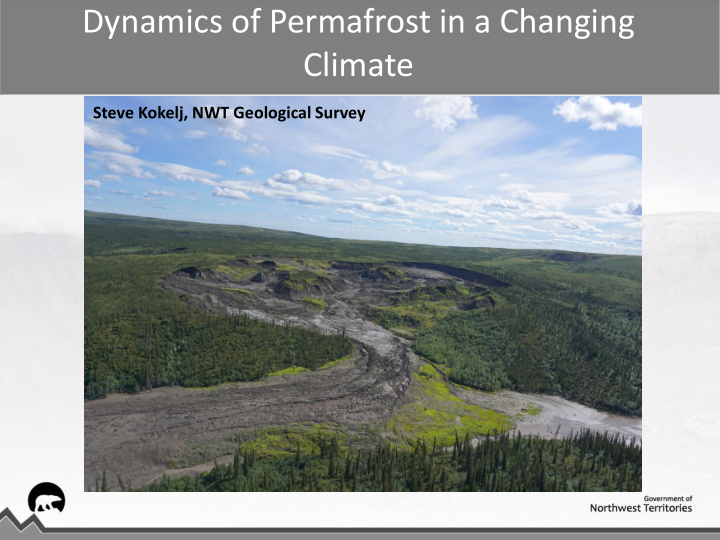



Dynamics of Permafrost in a Changing Climate Steve Kokelj, NWT Geological Survey
Permafrost and the environment People and Wildlife Permafrost
Canada is a permafrost country Heginbottom, 1995
Permafrost thickness 0 100 200 300 400 from S Wolfe, NRCan
Active layer Surface subsidence Active layer Post-disturbance active layer Ice-rich permafrost
Active layer and permafrost Active layer Near-surface permafrost Ice-rich zone
Ground temperatures in permafrost
Relations between air and ground temperatures S. Smith, NRCan
The influence of water bodies MAGT -7 o C Lake 3 o C Talik (unfrozen)
Talik adjustment due to warming and shoreline instability MAGT MAGT -7 o C -3 o C Lake Lake 3 o C 5 o C Massive ice Talik Talik (unfrozen) (unfrozen) Cold permafrost Warm permafrost
Warming permafrost, talik adjustment and lake bottom subsidence
Shoreline stability INF
The world of underground ice
Near-surface ice lenses Surface disturbance – increased thaw depth = Surface subsidence Active layer Active layer Ice-rich permafrost
Drunken forest = ice-rich terrain
Tundra polygons
Ice-wedge ice Thermal- contraction crack Photo from CR Burn French, 1996
Polygonal terrain Trough Polygon
Polygonal terrain
Massive ground ice Massive tabular ice
Massive ice and retreat of Laurentide ice sheet
Climate warming and permafrost
Warming air temperatures over the past 50 years
Hay River & Inuvik Mean Annual Temperatures Hay River = 3 o C per 100 years Inuvik = 7 o C per 100 years 24
Future Climate Projections Potential increase in winter temperatures 11.6 ° C from -28.6 to -16.3 http://tinyurl.com/snap-nwt
Projections of mean annual temperature made in 2003 0 0 Upper forecast Mean annual temperature ( C) -2 -2 1987-2016 -4 -4 Lower forecast Dawson -6 -6 1987-2016 -8 -8 Inuvik -10 -10 51-80 61-90 71-00 81-10 10-39 40-69 Climate interval From CR Burn; Camsell Lecture, 2017
Projections of summer rainfall made in 2003 From CR Burn; Camsell Lecture, 2017
Permafrost is warming 1970 2005 Mackay, 1974; GSC Burn and Kokelj, 2009; PPP
Permafrost change under future scenarios Chadburn et al., 2017; Nature Climate Change
Mean annual ground temperature profiles Yellowknife region Inuvik Quarry – Navy Road Burn et al., 2009, PPP Wolfe et al. 2015 GeoQuebec
Landscapes are responding to warmer and wetter conditions
Eastern Banks Island 1960s
Eastern Banks Island 2005
Eastern Banks Island 2016 Rudy et al., 2017 GRL
Increasing late season precipitation and landsliding
Increasing fall precipitation (9 years since 2002 in top 16 )
Reindeer Station landslides occur after heavy rains, September 2017
Reindeer Station landslides occur after heavy rains, September 2017
Capacity to develop geohazard risk maps are increasingly important for safety of residents and for planning infrastructure Rudy et al., NWT Geoscience Forum, 2017
How will the landscape respond?
Impacts to northern infrastructure 41 Fill Tongue Slumps Failure precursor Embankment Failure 2015 2016
Embankment fill 2015
Displacement vectors 1 Year movement R. Fraser, CCRS
Monitoring, analysis, informed decisions and adaptation 45
Inuvik to Tuktoyaktuk Highway Geotechnical legacy and informed decisions Thermal monitoring Several hundred geotechnical boreholes Remote sensing and terrain data Stream water quality
Management of permafrost geotechnical, ground temperature and geohazard data Available ground temperature Potential ground temperature monitoring data monitoring data
Summary • Permafrost is the geological manifestation of climate and provides foundation for billions of dollars of northern infrastructure and ecosystems • The state of permafrost is being altered by climate warming • Some permafrost landscapes are inherently susceptible to change • Consider uncertainty and anticipate encountering conditions without precedent
Summary • Information on permafrost temperature and geotechnical properties is critical for design and mitigation • Assessing geohazards and risk related to permafrost thaw is critical for public safety and for informed design • Monitoring can inform mitigation and future design • Managing this information is a foundational activity
Summary • Expect surprises, consequence of a poor knowledge base will be bigger and more costly surprises • Interaction between Engineers and Geoscientists will lead to advances in knowledge, design and adaptation • Resilience – build in flexibility and develop multiple options to deal with change and uncertainty
Summary Training and capacity is required
Thank you
Recommend
More recommend